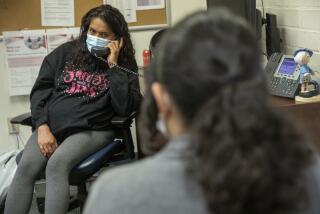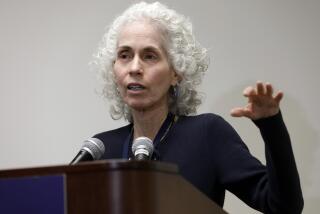Resources for those without insurance
- Share via
Healthcare without insurance is like construction without power tools.
It can be done, but it will take longer and require a lot more effort. And at times you’ll feel like you’re hammering your thumb.
“Preventive care is one of the most difficult areas,” said John Kim, head of the nonprofit Healthy City project, which has amassed data on medical and social resources in the Los Angeles area. “By the time you get care for the condition you’re trying to prevent, you might already have it.”
But as frustrating as the search can be, there are places to turn for people who have lost their insurance because of layoffs or cutbacks in benefits and don’t quality for subsidy programs such as Medi-Cal or Medicare.
Here’s a guide to major Los Angeles County resources and what you can expect if you’re not covered.
In conjunction with this article, Healthy City has put together a searchable database of hundreds of organizations that provide various kinds of preventive, dental and eye care at no or low cost. It can be found at www.healthycity.org.
The most important thing: Don’t neglect vital healthcare.
“One man came into the emergency room at Harbor-UCLA hospital and told doctors he had stopped taking his blood pressure medicine because he didn’t have insurance anymore and his doctor refused to see him,” said Carol Meyer, interim chief network officer of the Los Angeles County Department of Health Services.
“At the point he showed up, he’d been six months without his medicine. Turns out he had blown out a kidney -- he’ll be on dialysis for the rest of his life.”
--
Emergency care
This is one of the few areas of healthcare-without-insurance that’s covered by law. If you arrive at a hospital emergency room with a life-threatening condition, you can’t be turned away. You can be charged, however. But most hospitals have ability-to-pay programs that adjust the bill on a sliding scale.
If you have no insurance and can’t pay, a private hospital can transfer you after you’re stabilized to a public facility for continued care.
If you go directly to a county hospital emergency room, you probably will remain at that facility for continued care, if needed. But the wait to be seen for non-life-threatening conditions can be eight hours and more, Meyer said.
--
Non-emergency
If you have the flu, a sprained ankle or other condition that needs care but isn’t an emergency, you can go to walk-in clinics where the wait is often a couple of hours or less.
There are more than 100 of these clinics in Los Angeles County that are county-run or under contract with the county. All provide ability-to-pay care for the uninsured. A list of the clinics, by geographic area, can be found on the county health department site, www.ladhs .org.
Hospitals also provide non-emergency care, including surgery, for those who don’t have medical coverage. But the wait could be considerable.
“Let’s said you have a gallbladder problem that’s urgent but not an emergency,” Meyer said. “The wait for that surgery in one of our hospitals could be three, even five months.”
--
Preventive care
Don’t expect much in the way of physicals or other general exams from the cash-strapped county system. But there are other resources.
A federal program funded through the Centers for Disease Control provides free breast cancer screenings and Pap tests to eligible women. There’s also a state-funded program for breast cancer screenings. (See the adjoining box for websites and phone numbers.)
Local health fairs provide blood pressure readings and other tests, often for free, but you have to keep an eye out for these events. There’s no centralized listing -- look for announcements in newspapers or at community centers.
--
Medications
If you qualify for free or low-cost care at a hospital or clinic, prescription medications often will be provided on the same basis. In addition, hundreds of programs across the nation provide no- or low-cost medicines to the uninsured. A clearinghouse program started in 2005 by the Pharmaceutical Research and Manufacturers of America trade association makes them easier to find.
Called the Partnership for Prescription Assistance, the program searches for assistance by geography, need and financial status.
“It’s for anyone who is uninsured and struggling financially,” said Ken Johnson, senior vice president of the trade association. “We’ve seen an increase in applications of 10% to 15% in the past six months.”
Applications are taken at (888) 477-2669 and online at www.helpingpatients.org.
--
Dental
Government-funded dental services often don’t go much beyond emergency work.
But we’re in luck in Southern California because a few universities here offer dental studies and need folks to . . . well . . . practice on (under the watchful eye of faculty members). The program at UCLA’s School of Dentistry, for example, provides care at 50% or less of going rates. But it’s not for one-time use.
“Let’s say you only want one tooth taken care of or a one-time cleaning,” said Jeff Goldstein, director of the school’s Clinical Dental Center. “We would not accept you.
“We only do comprehensive care. You have to agree that we will be bringing your mouth up to optimum oral health.”
--
Mental health
The Mental Health Services Act, better known as Proposition 63, was approved by voters in 2004. But the first early intervention program in Los Angeles County funded by the initiative isn’t scheduled to start until at least the fall.
“One of the elements of that is short-term therapy for people who are uninsured,” said Marvin Southard, director of the county Department of Mental Health.
In the meantime, most of what the county provides in the field is emergency care for people who are seen to be a danger to themselves or others.
Some nonprofit institutions and private practitioners provide various types of non-emergency therapy on a no-cost or sliding-scale basis. The department’s help line -- (800) 854-7441 -- provides information.
--
--
(BEGIN TEXT OF INFOBOX)
Healthcare help
Here’s a list of resources if you don’t have healthcare insurance or other coverage.
HEALTHY CITY
The nonprofit group has created a database that contains hundreds of organizations providing free and low-cost care for the uninsured. The list is at www.healthycity.org.
COUNTY SERVICES
Los Angeles County: The L.A. County Department of Health Services has information at www.ladhs.org/wps/portal/Patient on its hospitals and clinic programs.
Orange County: Orange County care sites are at https://egov.ocgov.com/ocgov/Health (click on “Clinics and Hospital Locations.”)
Riverside County: Riverside County hospital and clinic information, as well as details of the county’s Medically Indigent Services Program for the uninsured, is at www.rcrmc.org.
San Bernardino County: San Bernardino’s county hospital is the Arrowhead Regional Medical Center, www.arrowheadmedcenter.org, which has several outpatient clinics.
Ventura County: Ventura County Medical Center, at www.vchca.org/mc, is the hub of that county’s public medical service system.
MEDICATIONS
The Partnership for Prescription Assistance program can help find reduced-cost or even free programs specifically for a patient’s locale and condition. For information, go to www.helpingpatients.org or call (888) 477-2669.
DENTAL
Services are available through UCLA’s Clinical Dental Center at about 50% of going rates. Information at www.dentistry.ucla.edu/patientcare or call (310) 206-3904 for the general clinic.
MENTAL
The Los Angeles County Department of Mental Health has a 24-hour help line at (800) 854-7771 that can give information on no- or low-cost services.
Source: Times research



